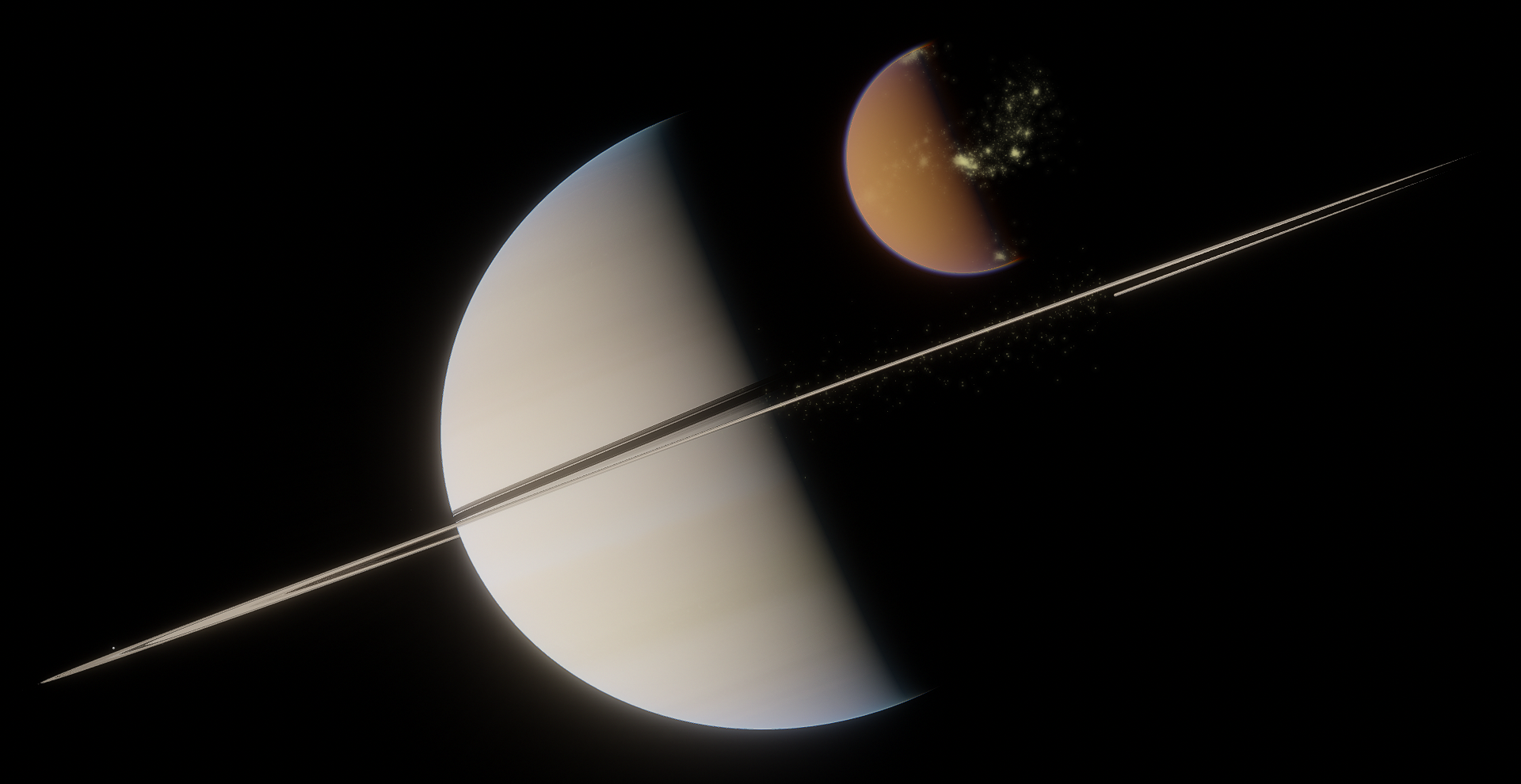Saturn
Saturn is the second-largest planet in the Sol system and seventh order from its sun. This gas giant is much smaller than its neighbor Jupiter, but its magnificent ring system of icy debris more than compensates for its size in renown. Saturn has seven planetoid moons, all small erimae except Titan which is a chiona. All of these, as well as dozens of minor moons and stations, are inhabited. Just over half a billion beings live in the Saturn Sphere, the majority humans –but, thanks to the Titan Cohabitation Compact, a small percentage of that half billion are Calypsians living on the largest moon, Titan.
Geography
Location
Saturn is the sixth planet out from its sun, Sol. It has 274 documented natural satellites, the largest and most significant of which is Titan. A few of its smaller spheroid moons, Enceladus and Dione, are quite similar to Jupiter's moon Europa: a cryonic world with a water ocean deep beneath their glacial crusts (although only Europa has endemic life). The Saturn Sphere is also swarming with human-built artificial satellites, the largest being the low-orbit station Phainon.Rings
Saturn's defining feature is its extensive, breathtaking ring system composed of innumerable tiny fragments of water ice in a circular ring roughly 20 meters thick. This system is divided into twelve rings, half of which are major: in order of distance from Saturn itself, the D, C, B, A, F, G, and E rings. The visible component of the rings is composed of the C, B, A, and F rings, as G and E are only visible in infrared or when backlit by the sun.Structure
Saturn is primarily composed of hydrogen and helium, with other light elements and gases comprising the rest. It has a core of semi-liquid metallic hydrogen, but as is typical for a gas giant Saturn lacks a solid surface. The outer cronian atmosphere is divided into several faintly visible bands at different latitudes, resulting in turbulence and storms along their boundaries, the largest of which is a giant hexagonal cyclone occupying the north pole of the planet.Aerocolonies
Since Saturn's gravity is only slightly higher than that of Earth, it is technically possible to set up habitats within its atmosphere. However, due to the gas giant's incredibly low density, it is very difficult to engineer large buoyant vessels. For this reason, the majority of Saturn's two million permanent residents inhabit comparatively small habitats supported by vast vacuum balloons and wind-wheels, scattered across the equatorial latitudes of the planet. Most of these platforms primarily exist to extract usable energy from the kinetic chaos of the atmosphere, which is beamed up to a relay network in orbit and transmitted across the Saturn Sphere.Ecosystem
Saturn itself does not host any confirmed biosphere, but its moon Titan plays host to very rudimentary protocellular biochemistry within its hydrocarbon seas.Natural Resources
Saturn is a bountiful source of both hydrogen, used commonly in fusion reactors, and its antimatter counterpart (used in antimatter catalyst reactors, notably for warp drives). As a result, numerous lucrative aeromining operations have been staged in various levels of Saturn's upper atmosphere and lower exosphere. The wind shear differentials between various layers and latitudes of the atmosphere are also a reliable source of power, which is harvested and beamed across the Saturn Sphere by a co-op energy network. By far the most prolific industry in the Saturn Sphere is the water trade, with so many sources easily accessible from the rings and moons that Saturn has become well known as the dominant water supplier to the entire Sol system. Supplementing this is the refinement and export of organic chemicals, primarily based out of Titan, as well as engineering innovations developed by the advanced local technocultures. Lastly, but perhaps most importantly: Saturn's legendary rings attract millions of visitors per metric year, making tourism a surprisingly large facet of the collective Saturnian economy.Archive Data
HAZARDS
PHYSICAL CHARACTERISTICS
- 98.3% hydrogen
- 3.25% helium
- 0.45% methane
- <0.1% other gases
HABITATION INFORMATION
(SATURN)
HABITATION INFORMATION
(SATURN SPHERE)







Comments